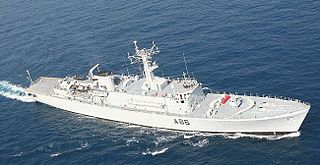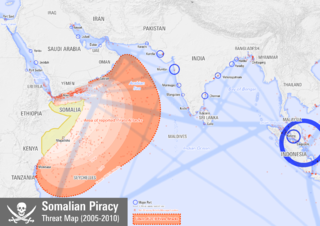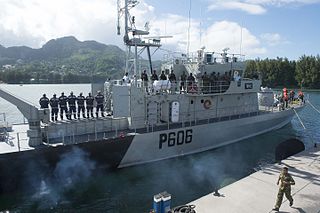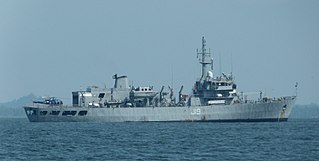
USS Farragut (DDG-99) is an Arleigh Burke-class destroyer in the United States Navy. She is the fifth Navy ship named for Admiral David Farragut (1801–1870), and the 49th ship of the Arleigh Burke class.

INS Tabar (F44) is the third of the Talwar-class frigate of the Indian Navy. The frigate was commissioned on 19 April 2004 in Kaliningrad, Russia with Captain Biswajit Dasgupta. The current Commanding Officer (CO) of INS Tabar is Captain Mahesh Mangipudi.

HDMS Esbern Snare (F342) is an Absalon-class frigate and is, along with her sister ship, the HDMS Absalon, amongst the largest combat vessels currently commissioned in the Royal Danish Navy.

The action of 18 March 2006 occurred when two United States naval vessels were attacked by pirates. The U.S. ships were part of Combined Task Force 150.

The Car Nicobar class of high-speed offshore patrol vessels are built by Garden Reach Shipbuilders and Engineers (GRSE) for the Indian Navy. The vessels are designed as a cost-effective platform for patrol, anti-piracy and rescue operations in India's exclusive economic zone. In 2023, one of the ships, INS Tarmugli, was donated to the Maldivian Coast Guard.
Piracy off the coast of Somalia occurs in the Gulf of Aden, Guardafui Channel, and Somali Seain Somali territorial waters and other surrounding places and has a long and troubled history with different perspectives from different communities. It was initially a threat to international fishing vessels during the early 2000s, only to rapidly escalate and expand to international shipping during the War in Somalia (2006–2009).

Operation Atalanta, formally European Union Naval ForceSomalia, is an ongoing counter-piracy military operation at sea off the Horn of Africa and in the Western Indian Ocean, that is the first naval operation conducted by the European Union (EU). The operational headquarters is currently located at the Spanish Operation Headquarters (ESOHQ) at Naval Station Rota in Spain, having moved from London as a result of the British withdrawal from the EU.

MV Tygra is a container ship currently operated by the Waterman Steamship Corporation and owned by Element Shipmanagement SA of Piraeus, Greece. She was previously owned by the A.P. Moller-Maersk Group and operated by Maersk Line and Maersk Line Limited.
The action of 30 March 2010 was a naval battle involving a patrol boat of the Seychelles Coast Guard and two groups of Somali pirate vessels. The encounter resulted in the freeing of twenty-seven hostages held by the pirates.
The Seychelles Coast Guard (SCG) is a branch of the Seychelles People's Defence Force created in 1993. It is a maritime, military, multi-mission service. They acquired responsibility for search and rescue for vessel incidents as well as environmental protection from the Seychelles Port Authority, formerly known as the Port and Marine Services Division.

INS Tir (A86) is the first dedicated cadet's training ship to be built by Mazagon Dock Limited and commissioned as such by the Indian Navy. She is the senior ship of the 1st Training Squadron of the Southern Naval Command.

INS Talwar (F40) is the lead ship of the Talwar-class frigates of the Indian Navy. Its name means "Sword" in Hindi. She was built in Russia, and commissioned into the Indian Navy on 18 June 2003.

The Battle of Minicoy Island was a single ship action in January 2011 between Indian naval forces and Somali pirates, during Operation Island Watch. Pirates in the former Thai fishing trawler Prantalay 14 resisted and attacked the Indian Navy warship Cankarso and, in a long surface action off Minicoy Island, the Indians sank the hostile ship and rescued twenty captives.

The MV Beluga Nomination incident was the capture and attempted liberation of a German freighter from Somali pirates by the Seychelles Coast Guard and Royal Danish Navy in January 2011. A few days after the taking of MV Beluga Nomination, a Seychelles patrol boat and a Danish flexible support ship, HDMS Esbern Snare, encountered the pirates and engaged in a failed rescue operation.

Operation Ocean Shield was NATO's contribution to Operation Enduring Freedom – Horn of Africa (OEF-HOA), an anti-piracy initiative in the Indian Ocean, Guardafui Channel, Gulf of Aden and Arabian Sea. It follows the earlier Operation Allied Protector. Naval operations began on 17 August 2009 after being approved by the North Atlantic Council, the program was terminated on 15 December 2016 by NATO. Operation Ocean Shield focused on protecting the ships of Operation Allied Provider, which transported relief supplies as part of the World Food Programme's mission in the region. The initiative also helped strengthen the navies and coast guards of regional states to assist in countering pirate attacks. Additionally, China, Japan and South Korea sent warships to participate in these activities.

Piracy in Somalia has been a threat to international shipping since the beginning of the country's civil war in the early 1990s. Since 2005, many international organizations have expressed concern over the rise in acts of piracy. Piracy impeded the delivery of shipments and increased shipping expenses, costing an estimated $6.6 to $6.9 billion a year in global trade in 2011 according to Oceans Beyond Piracy (OBP).

PS Contant is a Trinkat-class patrol vessel owned and operated by the Seychelles Coast Guard. She was formerly operated by the Indian Navy as INS Tarasa (T63). India, as well as the United Arab Emirates, have helped equip the Seychelles Coast Guard with patrol vessels. India and the UAE helped equip the tiny Seychelles with these patrol vessels due to its strategic location, very near the area off the Horn of Africa that is notorious for pirate attacks.

PS Topaz is a Trinkat-class patrol vessel owned and operated by the Seychelles Coast Guard. She was formerly operated by the Indian Navy as INS Tarmugli (T64). India, like China and the United Arab Emirates, have helped equip the Seychelles Coast Guard with patrol vessels. India, China, and the UAE helped equip the tiny Seychelles with these patrol vessels due to its strategic location, very near the area off the Horn of Africa that is notorious for pirate attacks.

INS Nirdeshak (J19)(Hindi: निर्देशक lit. director) was the sixth ship of the Sandhayak class of the Indian Navy. The ship operated as a hydrographic survey ship in the Indian Navy, under the Eastern Naval Command. Nirdeshak was equipped to prepare a variety of marine charts and maps for ECDIS system. The ship's secondary role was to conduct humanitarian aid and disaster management operations, wherein the ship could be converted into a hospital ship. The ship was also equipped with an operating theater and associated equipment needed to attend to medical emergencies at sea.
MV OS 35 is a bulk carrier registered in Tuvalu, a flag of convenience. The vessel first came into news when a piracy attack on her off the coast of Somalia was thwarted jointly by ships of China’s People’s Liberation Army Navy and of the Indian Navy.















